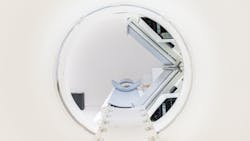Purdue team creates stretchable, wearable coils to make medical tests easier for patients
Purdue University researchers have taken technology used in the defense and aerospace industries to create a novel way of doing some medical imaging to enhance comfort for patients. The Purdue team has developed radio-frequency (RF) coils that are formable and stretchable to detect signals from the body. The team’s work appeared in the journal IEEE Transactions on Biomedical Engineering.
“Imagine going for an imaging session and they strap on a comfortable fabric with the coils embedded inside,” said Joseph Rispoli, an assistant professor of biomedical engineering and electrical and computer engineering in Purdue’s College of Engineering. “We created an adaptable, wearable and stretchable fabric embroidered with conductive threads that provides excellent signal-to-noise ratio for enhanced MRI scanning.”
Current approaches to enhancing signal-to-noise ratio, known as SNR, include shaping receive coil arrays to encompass a generalized form of the body part of interest, but these are often rigid and require the patient be posed in a specific way. The Purdue flexible and stretchable coil could be placed close to the skin on an area or joint, regardless of its positioning. The thread technology used in the coil is similar to that found in applications for the aerospace and defense industries. Rispoli said the technology also is applicable to breast MRI and to enhancing medical device communication using wearable or implantable antennas.
“Our preliminary results show a full-scale device will be superior in all aspects of diagnostic testing, including increased sensitivity and fewer false positives,” Rispoli said.
The team is working with the Purdue Research Foundation Office of Technology Commercialization to patent the technology and is looking for partners to continue developing their technology. They presented the technology at the International Society for Magnetic Resonance in Medicine Annual Meeting and the IEEE International Engineering in Medicine and Biology Conference.
